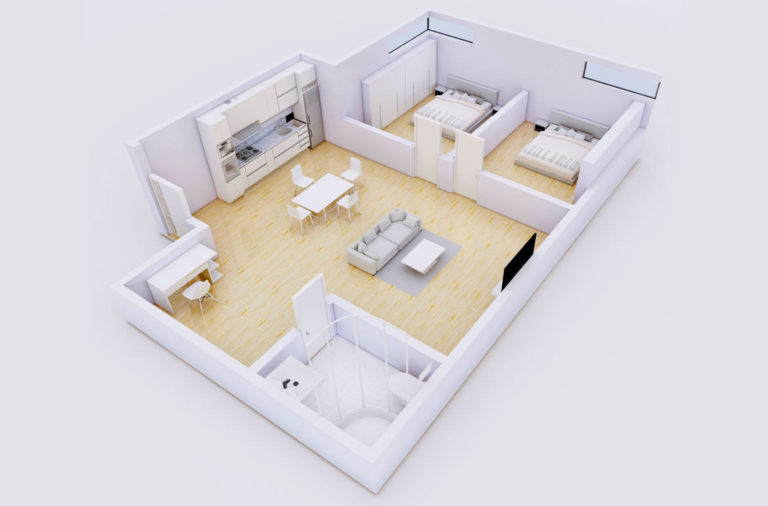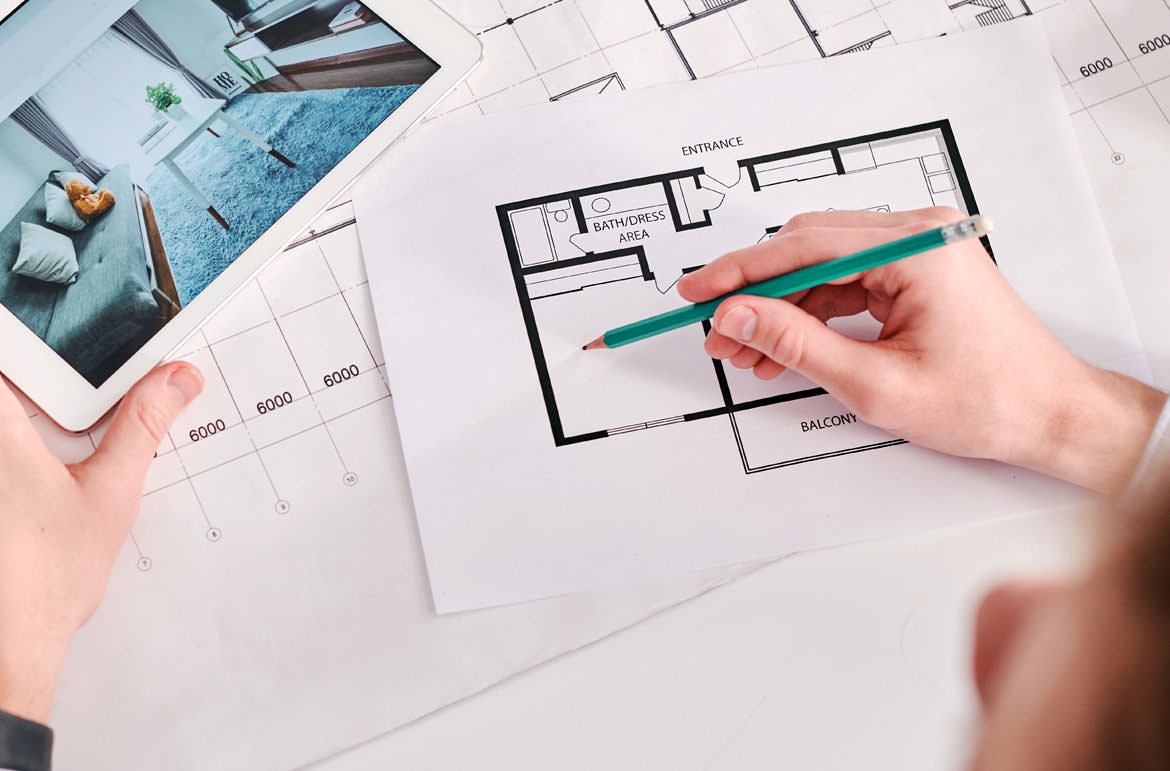
An important part of building a granny flat is getting floor plans drawn. So, what do granny flat floor plans show?
A floor plan is a two-dimensional plan, drawn to scale, of the granny flat drawn from above, showing its’ layout from about a metre above ground level. The plan shows the whole dwelling, including measurements, each individual room, and its’ appliances.
Today I’ll cover the purpose of floor plans. I’ll talk about floor plans for studio, one-bedroom, and two-bedroom granny flats. I’ll show you the floor plan for my granny flat, explaining what it means. I’ll discuss what a floor plan needs, and the differences between these and a site plan.
DON'T PAY A FORTUNE FOR YOUR GRANNY FLAT. Find out how to deal with council and build a granny flat for the lowest cost possible. Learn More.
We have a lot to cover, so let’s start.
What is the Purpose of a Floor Plan
A floor plan is essential when designing your granny flat. It can create a flow between the areas, giving it a lovely feeling.
NOTE: Below is my exact 2D Floorplan as published in the Owner-Builder Magazine
However to make it easier to imagine I worked with BT + Najam designers to craft 3D floor plans (from a top view)
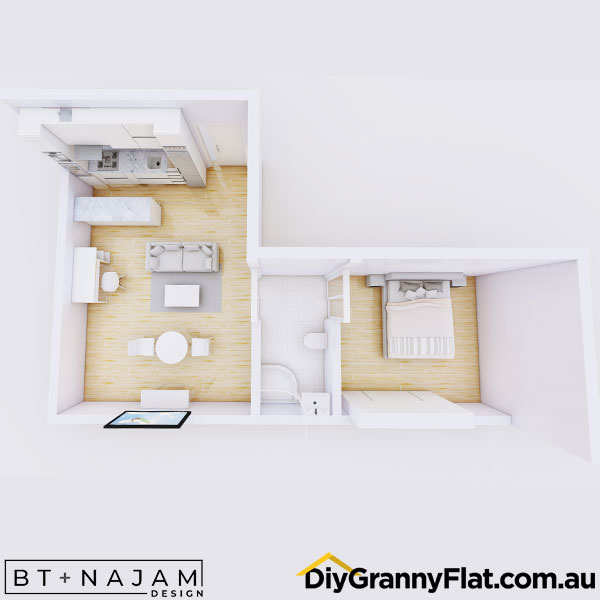
Sometimes you are restricted in the shape your granny flat needs to be
Floorplans are also used to help design the layout wiring systems, install plumbing, and more.
You can hire a designer, such as an architect or drafter, to draw your floor plan.
Checking your land, and getting your reports from your surveyor and engineer, they can then start to create floor plans, that include things such as:
- Your maximum floor space – Between Council regulations for maximum floor space, and your land size requirements including landscaping and setbacks, the design should make best use of your land.
- Insulation – To meet, or even exceed, BASIX requirements.
- Energy efficiency – Letting in natural light, and incorporating passive solar heating.
It’s important to speak to your designer about the floor plans, telling them exactly what you envision – this will ensure you get your dream granny flat.
Studio Granny Flat Floor Plans
It really helps to see a top down view of you granny flat to grasp the dimensions and where things need to fit.
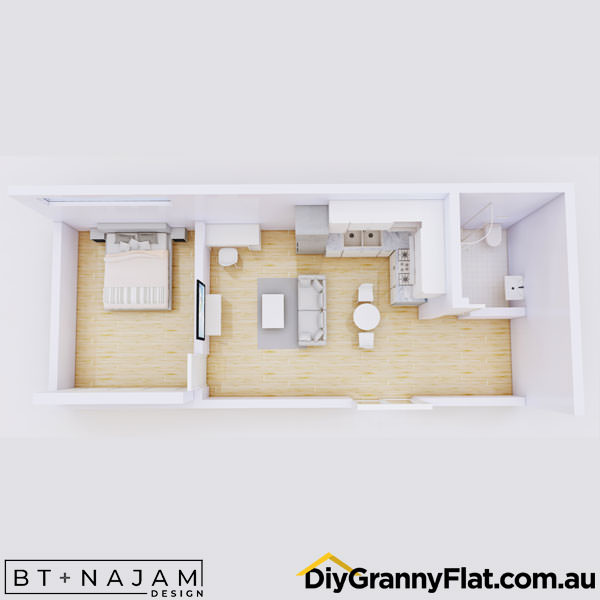
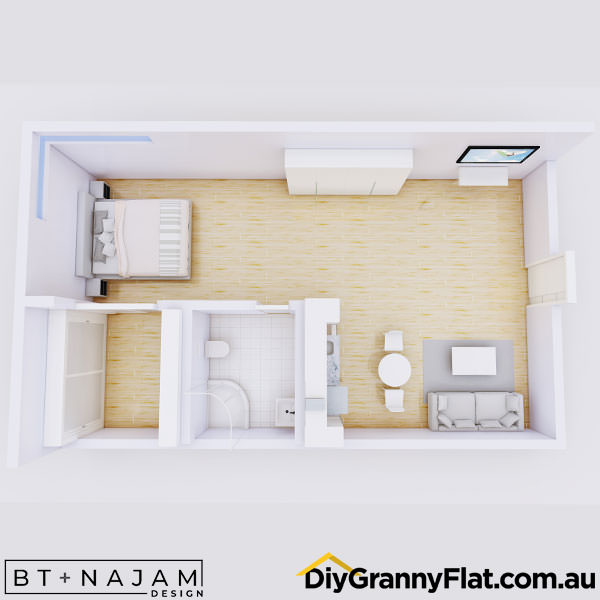
A good floor plan for a studio granny flat will include:
- A Deck (if you have the space).
- A Multi-Use Room – for example, it can incorporate a home office.
- An Open Plan Kitchen/Kitchenette, Living and Dining Area.
- A Bathroom.
For ideas, such as thinking about whether you can remove rooms and share them in the main home, feel free to read more about Studio Granny Flats
1 Bedroom Granny Flat Floor Plans
1 bedroom granny flats work well to cordon off space for living/working and resting
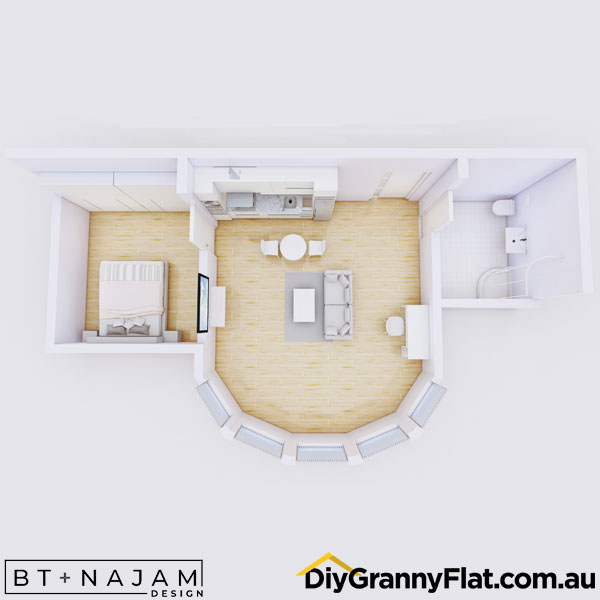
If you have the funds or are willing to do some heavy lifting, the cost of this design (in construction) could be off set.
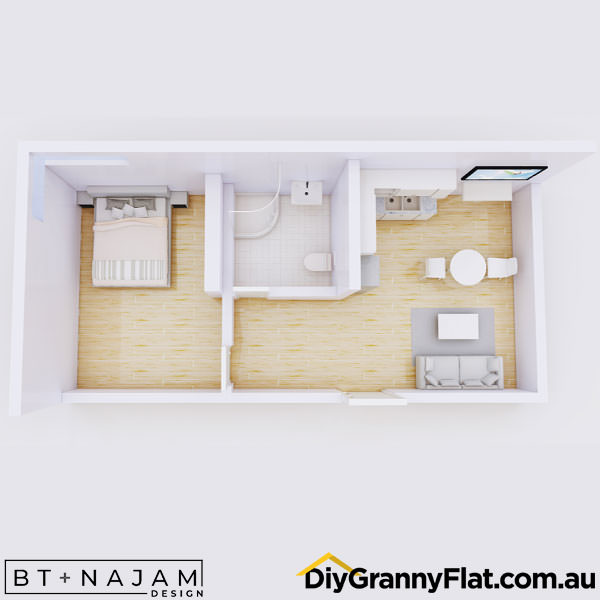
A good floor plan for a 1-bedroom granny flat will have:
- A Bedroom with an En-Suite.
- Open Plan Kitchen, Living and Dining Area.
- Storage and Space-Saving Solutions.
- An Outdoor Area.
- Windows and Doors.
- Multi-Use Rooms.
For inspiration on a great design ideas, feel free to scroll through this post about 1 Bedroom Granny Flats.
2 Bedroom Granny Flat Floor Plans
As well as the above, other things to consider in a 2-Bedroom granny flat are:
- Layout – For example, consider the tenants privacy.
- Bathrooms – Ensure the bathrooms work with how the “mains” water comes into the granny flat.
It’s also important to keep your design versatile. Think about not only who your tenants’ will be now, but who they may be in future, and then what the rooms will be required for.
For more ideas, you can see even more 2 Bedroom Granny Flat designs here.
My Granny Flat Floor Plan & What Everything Means
When considering granny flat designs in general I ended up using a local designer for my floor plans.
There’s quite a lot of detail on this, so I’ll explain what it means.
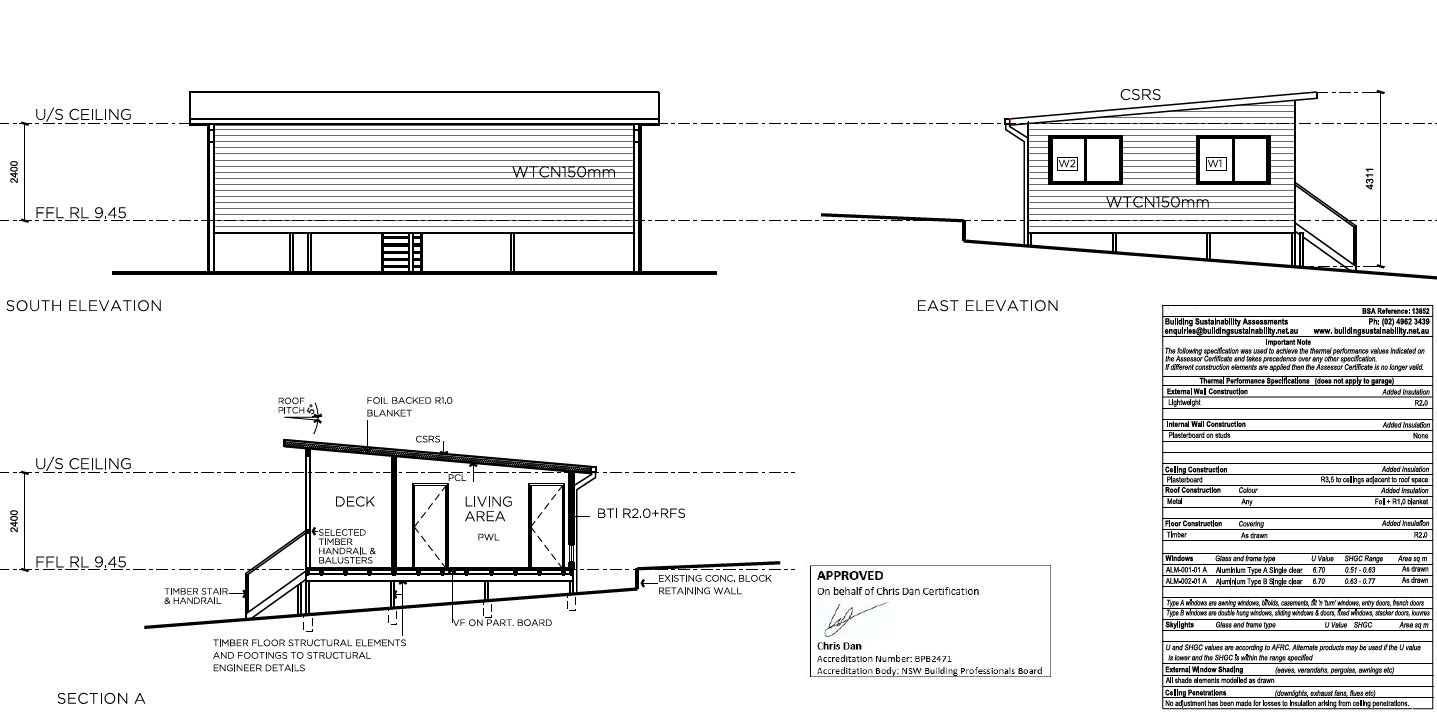
These are the typical types of plans you will be issued with from your designer
External View
At the top of the plan, there’s an external view of my granny flat, facing both north, east and west, confirming:
- The material it’s constructed from (“WTCN150mm” = Cement Fibre Cladding 150mm wide).
- Where the front and side windows are placed (I’ll elaborate on this under Windows below).
- The floor level and ceiling height (2400 = 2.4m at the lowest point), and
- The roof pitch (5 degrees).
Then, we move onto the birds-eye view, which is a diagram of the below:
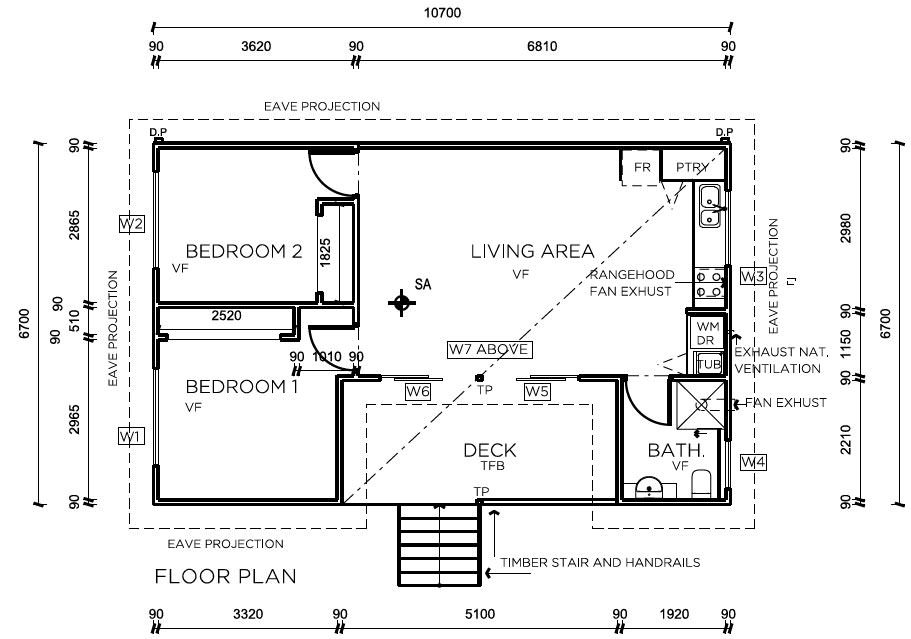
The submission ready for council approval
Walls & Measurements
The exterior and interior of my granny flat is defined by thick, double lines, showing how the rooms are laid out, their shape, and size. The double lines are also marked as “90” – meaning the internal walls are 90mm. This shows that, by removing some walls for an open plan kitchen, living and dining area, I gained more room.
Exterior
Beyond the walls, you can see where my eaves extend.
The “D.P” on the upper right and left is where my down pipe is placed.
Doors
Leading into the bedrooms and bathroom, you’ll see a quarter circle shape. This depicts the doors opening into the rooms. The gap between the living area and deck is my sliding door.
Floors
My 2 bedrooms, living area, and bathroom are labelled “VF” – or, Vinyl Floor. My deck is labelled “TFB” – Timber Floor Boards.
Stairs
My stairs leading onto the deck have an arrow pointing in the direction of which way is up. It also states these are timber, and there are handrails.
Windows
The precise location of my windows are labelled on the floor plan as “W1” (Bedroom 1), “W2” etc…
Fittings, Fixtures, Appliances
All fittings, fixtures and appliances are either drawn or labelled. These are:
- Living Area – “FR” (fridge), “PTRY” (pantry), the kitchen sink, though not labelled, is clearly visible, the “Rangehood Fan Exhust” is the exhaust fan above the full-size oven you can also see drawn.
“WM” (Washing Machine), “DR” (the fold-out washing line), and “TUB” (the laundry sink). It’s also labelled that there’s exhaust and natural ventilation here.
- Bathroom – You can clearly see the shower and toilet drawn. It’s also labelled that there’s an exhaust fan.
- Bedrooms – The areas labelled “2520” and “1825” are built-in robes with mirrors.
Orientation

You’ll notice a compass similar this – it depicts which way is north, thus how my granny flat is orientated.
What a Granny Flat Floor Plan Needs
A floor plan should have:
- A determined area – The granny flat should be based around the location where its’ size and shape makes best use of your land.
- Measurements – The total area of the granny flat.
- Interior walls, defining each room – Walls for every room of the granny flat should be included, drawn to scale. Each room should be labelled for its’ purpose.
- Features – Things that will be unchangeable – some architectural, some appliances – must be included. For example, all windows and doors, the refrigerator, oven, washing machine, etc., should be shown in their exact location.
When your draftsperson, designer or architect creates your floorplan (like my example above) you can ask if they will create a 3D render for you as well.
I am a visual person, so this helps me to see what it will look like on the building envelope (Where you are allowed to build your granny flat).
Especially for odd shaped granny flats – just like these examples below:
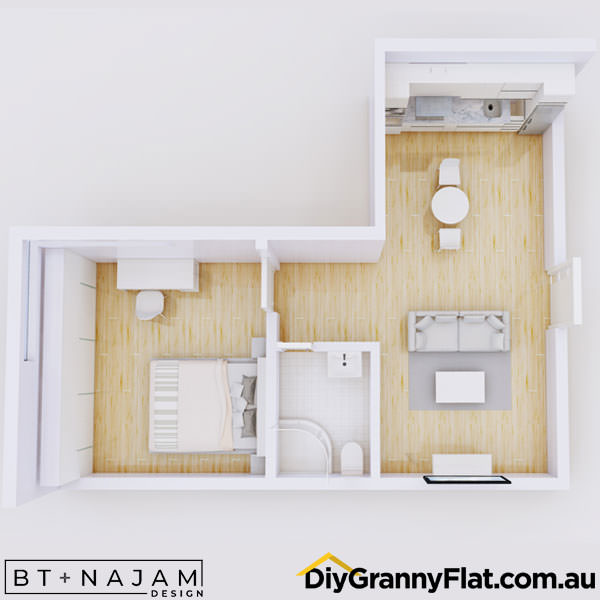
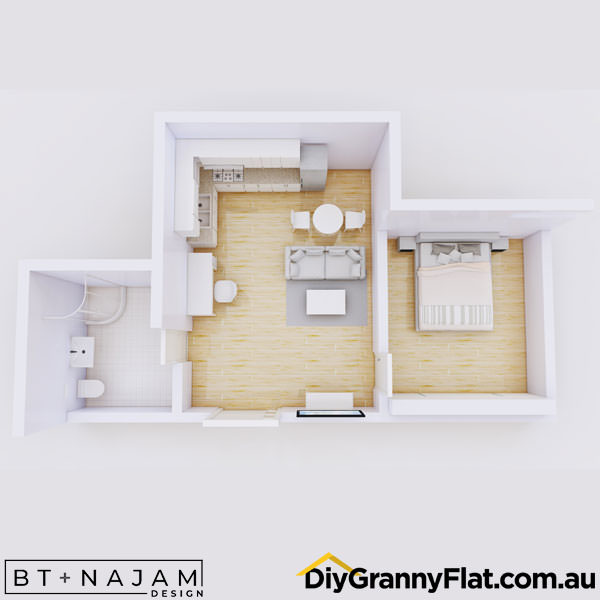
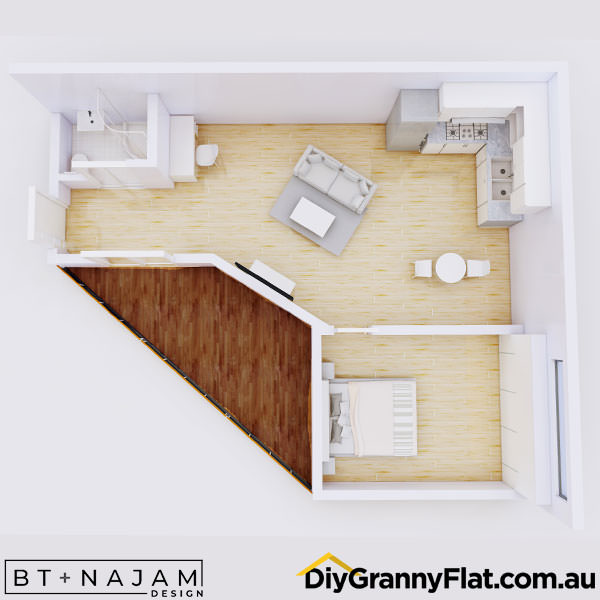
Basically, any horizontal surface that’s attached to the structure of the granny flat should be on a floor plan. This includes any items that are attached to the walls or floor, such as stairs and handrails. Some floor plans will also show furniture, giving it some atmosphere and scale.
Remember, this is your granny flat, and you should be getting a vision of what it looks like, which should match what you want. It may be your last chance to change some things, so if it doesn’t meet your vision, you should change it now.
What is the Difference Between a Site Plan vs. a Floor Plan
Many people think a site plan is the same as a floor plan. But they’re very different things.
Whilst both a drawing representing three-dimensional objects in two dimensions, drawn from above, they show different details of your proposed building and its’ surrounding.
Floor Plans
A floor plan shows the layout of the granny flat from a certain level above ground, with the roof removed. This lets you see its’ design – the walls, the shapes and measurements of rooms, the placement of doors and windows, features such as appliances, and how spaces inside and outside join together.
Site Plans
A site plan shows where the granny flat is going to be located on the property, and its’ orientation. So, the site plan shows the granny flat design, but its’ main focus is on its’ surroundings. The drawings show a higher level of detail of the land bordering the granny flat, such as the:
- Property’s boundaries, as recorded.
- Physical topography within this area – that is, natural features i.e., trees, landscaping, waterways, etc.
- Proposed construction features, i.e., walkways or driveways.
It will also include all legal restraints that impact the proposed building, including:
- Zoning regulations.
- Site utilities.
- Entry points, and
- Notable environmental features, such as trees taller than 6m.
Conclusion
When designing your granny flat, you will have to make numerous choices, your floor plan being just one.
I also feel a render puts everything in perspective. As it creates a great way to see how the furniture might fit in as well.

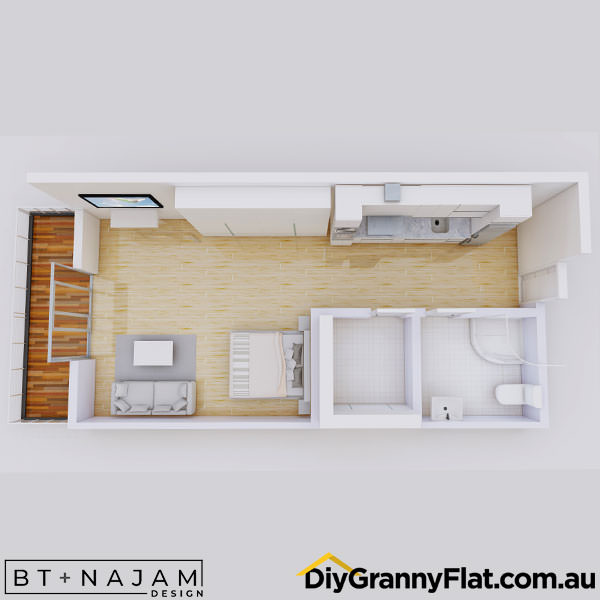
It may help to read how I noted my costs and set my budget, and Granny Flat Layouts – The “Must Read” Checklist Before Building.




